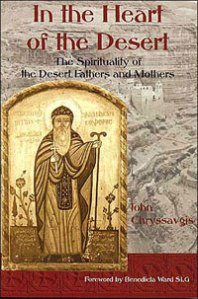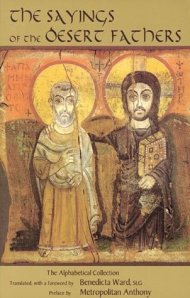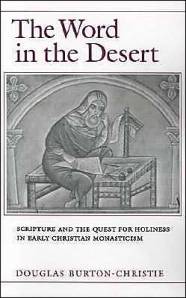
An excellent introduction to the Desert Fathers and Mothers is John Chryssavgis’ “In the Heart of the Desert. The Spirituality of the Desert Fathers and Mothers” (2003). Dr Chryssavgis (b.1958) was educated in Australia and Greece, and has taught at St Andrew’s Greek Orthodox Theological College in Sydney, and Holy Cross School of Theology, where he is now Professor of Theology. After a brief introduction to the history of the sayings, the historical background to the Desert Fathers and Mothers, and the major figures of Desert Spirituality, the author devotes the great majority of his work to an exploration of the key themes of Desert Spirituality. These include “The Desert as Space”, “The Struggle Against Demons”, “Silence and Tears” and “The Power of Detachment”. There are chapters on the role of spiritual guidance, and on the education and formation of a Desert Father or Mother. Dr Chryssavgis’ excellent volume concludes with the first translation into English of Abba Zosimas’s “Reflections”, a work compiled in the first half of the sixth century, which records many sayings of the Desert Fathers.
In his final words, Dr Chryssavgis reminds his readers:
“The desert is a profound myth. It is a powerful symbol. These fourth-century elders are reminders of fundamental truths about our world and ourselves, which we tend to forget and which they translate for all generations throughout the ages. They should be considered as being prophets of another reality – in many ways, the only reality – rather than strange representatives of a remote past or inaccessible examples of former times.
Nonetheless, no one can lead us into the desert. Each one of us must find our own way. Each must look for the places where they are tempted, where we are lonely, thirsty for meaning and hungry for depth. Each of us will discover the areas that need to be purified, where we can encounter God and where God speaks to us. The desert is only one expression or translation of the truth, like art, music and beauty. Each of us must discover the ways of appropriating and appreciating this truth. We may question the truth conveyed by these desert elders, though we can never deny it.” [Chryssavgiss, “In the Heart of the Desert” 2003:109
Two standard works, now available in matching form and published by the Cisterians are “The Sayings of the Desert Fathers. The Alphabetical Collection” (1975) translated by Benedicta Ward, and “The Lives of the Desert Fathers” (1981) translated by Norman Russell.

Benedicta Ward has done much to enhance awareness of the Desert Fathers and Mothers. She was educated at Manchester and Oxford Universities, and is a member of the Anglican religious community, the Sisters of the Love of God. “The Sayings of the Desert Fathers. The Alphabetical Collection” (1975), which she has translated, is prefaced by a Foreword providing an historical background to the Fathers and to the text, and to the spirituality of the Fathers. The author’s insight, not to say wit, provides great insights into her subject. To provide but one example:
“The desert was not a gigantic gymnasium where athletes vied with one another in endurance tests. When one of the fathers went in disguise to a monastery during Lent, he outdid all the monks in asceticism. His name was Macarius the Egyptian and he was very tough. At the end of a week, the abba led him outside and said, “You have taught us all a lesson, Father, but now please would you mind going away, lest my sons become discouraged and despair. We have been edified enough.”” [Ward, 1975:xxv]
The collections of apothegms are arranged alphabetically (albeit according to the Greek alphabet, so they commence with alpha and conclude with omega), with each collection introduced by a brief biography (where such exists) for the Father whose sayings follow. The language is less poetic than that of Waddell, but concise and clear. The following example is typical:
“Abba Isidore of Pelusia said, “To live without speaking is better than to speak without living. For the former who lives rightly does good even by his silence but the latter does not good even when he speaks. When words and life correspond to one another they are together the whole of philosophy.”” [Ward, 1075:98]
Ward’s collection concludes with a helpful glossary, a “Chronological Table for Early Egyptian Monasticism”, a Select Bibliography, a general index and an index of people and places.

Norman Russell is a Catholic Priest of the London Oratory. His “Lives of the Desert Fathers” (1981) is the first English translation of “Historia Monachorum in Aegypto”, an account of the Desert Fathers given by seven monks from Palestine who travelled through the Egyptian desert in 394AD. Their pilgrimage was not unique; in the late fourth century many visitors, including Rufinus the friend of Jerome, sought out the Fathers. This translation begins with a valuable introduction by Benedicta Ward, who provides the historical background to the journey which led to the account, and the social and spiritual context of the Fathers and their monastic lives. Her Introduction includes a chapter entitled “A Sense of Wonder: Miracles in the Desert”, relevant because of the frequency of the miraculous in the “Historia”: clairvoyance, dreams (prophetic and demonic), cures, supernatural powers over animals and demons, and the power of spiritual discernment.
The actual text of the “Historia” itself is short (only seventy pages including the Prologue); to this Ward adds a substantiate body of annotations (pp.123-138) and “The Additions of Rufinus”, comprising sections which differ between the text of Rufinus and the Greek text of the “Historia”, and a further section on “The Syriac Version”, which notes the differences between the Greek and Syriac versions (which exist in Ananisho’s “Paradise of the Holy Fathers”, the complete text of which is translated by Budge (1907)). A bibliography of of primary and secondary sources, a Chronological Table, an Index of Persons and Place and a Subject Index complete Ward’s important work.

Helen Waddell’s translation of parts of the “Vitae Patrum”, “The Desert Fathers” (1962) has been a standard work in the area since it was first published in 1936 and seems, happily, never to have been out of print since then. She has spent much of her professional career in translation, notably of medieval Latin poetry. This book contains extracts from ten of the major ancient collections of the apothegms: St Jerome’s life of St Paul the First Hermit; Rufinus of Aquileia’s History of the Monks of Egypt; “The Sayings of the Fathers” translated from the Greek by Pelagius and John; “The Sayings of the Fathers” from the Greek by an unknown translator; Paschasius the Deacon’s translation of “The Sayings of the Fathers”; John Cassian’s texts “Of Accide” and “Of Mortification”; the Paradisus of Palladius; the Pratum Spirituale of John Moschus; James the Deacon’s “The Life of St Pelagia the Harlot”; and “The Life of St Mary the Harlot” by St Ephraem of Edessa. The work is prefaced by an excellent general introduction focussing on the spiritual themes underlying the apothegms, and each of the selections from the ten works is preceded by an introduction to that work. The English translation is fluid and lively, as is seen in the following apothegm from St Antony:
“The abbot Pambo asked the abbot Antony, saying, “What shall I do?” And the old man made answer, “Be not confident of thine own righteousness; grieve not over a thing that is past; and be continent of thy tongue and of thy belly.”” [Waddell, 1962:80]
Waddell’s work lacks an index or a bibliography but, in one of the many available small paperback editions, it is a work eminently suitable for keeping by the bedside, no less than carrying in the briefcase, as a constant source of interest and inspiration.

Laura Swan’s “The Forgotten Desert Mothers. Sayings, Lives, and Stories of Early Christian Women” (2001) is an engaging, if also challenging introduction to what has for too long been a gap in the understanding of early Christian spirituality: the role of women, and the nature of women’s spirituality in the early Church. The author is a Benedictine nun, and Prioress of a Benedictine monastery in the northwest USA. Swan provides a useful introduction to “The World of the Desert Mothers” and “Desert Spirituality” which she describes thus:
“Desert spirituality is characterized by the pursuit of abundant simplicity – simplicity grounded in the possession of little – and the abundance of God’s presence. Yearning for complete union with God, desert ascetics sought to remove all obstacles to the deepening of this relationship. Obstacles included unhelpful attitudes and motives, thoughts that stalled their pursuit of God, and emotional ties that complicated their inner journeys.” [Swan, 2001:21]
Swan provides brief lives and examples (where these exist) of apothegms from the Desert Mothers, together with a survey of the “Lesser Known Desert Mothers”, and an overview of the role of Deaconesses in the Early Church. Her definition of Desert Mother is broad, and she cites examples from outside Egypt and the Middle East, including Mothers from France and Italy. Her quotations from the Mothers are interesting and inspiring, as is shown in an example of an apothegm from Amma Theodora:
“The same Amma said that a teacher ought to be a stranger to the desire for domination, vainglory, and pride. A teacher should not be fooled by flattery, nor be blinded by gifts, conquered by the stomach, nor dominated by anger. A teacher should be patient, gentle, and humble as far as possible; successfully tested and without partisanship, full of concern and a lover of souls.” [Swan, 2001:67]
Swan also explores the role of community leaders in women’s’ monasticism in a chapter entitled “Mentors of the Monastic Way”. Her work concludes with a “Timeline of the Forgotten Desert Mothers”, and Appendix on the ancient Ordination Rite of Deacons and Deaconesses, a Glossary, “A Calendar of Feasts of Holy Women” and a bibliography. Unfortunately, the work lacks an index.

An excellent study of the lives of the Fathers and Mothers is Lucien Regnault’s “The Day-to-Day Life of the Desert Fathers” (1999) which, while a significantly scholarly work, is written in lively and stimulating style, probably indicative of the author’s enthusiasm for his subject, for more than forty years the focus of his research. Regnault is part of that community of scholars at the Abbey of Solesmes which has been devoted to the study of early Christian spirituality in general, and of the monks of the Near East in particular. Regnault provides a comprehensive study of what might be though of as the practicalities of desert life, without ever ignoring the underlying spiritual purpose. His chapters address habitat, clothing, diet, life in the cell, the roles of elders and disciples, the reception and influence of visitors and the activities by which the Fathers and Mothers occupied their time. His chapters on “Angels and Demons” and “The Desert Bestiary” provide a fascinating source of information on the natural and supernatural worlds within which Desert Spirituality developed. In the chapter on “The Wonders of God”, Regnault explores the miraculous elements in the life of the Desert Fathers and Mothers – predictions and revelations, apparitions and visions, miracles and healings. But he notes that “the humility of these anchorites was sorely tested by such miracles”:
“All of them knew well that such power doesn’t constitute holiness. Agathon put it, “The quick-tempered, even if he resurrects a dead person, is not pleasing to God.” And Abba Nesteros said to Cassian: “The sum of perfection and of beatitude doesn’t consist in doing wonders, but in the purity of charity.”” [Regnault, 1999:222]
Regnault concludes with an interesting comparative time-line of landmarks in “The Church and the World” and in monastic Egypt, and a bibliography of primary and secondary sources. The only index is one of the Desert Fathers and Mothers and those who had contact with them.
This small (257 pp) paperback provides a lively, comprehensive introduction to the day-to-day lives of the Desert Fathers and Mothers, encouraging (through such small details as accounts of their use of bread and oil, lentils and chickpeas) a sense of familiarity with these remarkable men and women.

For those seeking to understand in greater depth the ascetical theology of the Fathers and Mothers, two remarkable and magnificent works should be studied: Burton-Christie’s “The Word in the Desert: Scripture and the Quest for Holiness in Early Christian Monasticism” (1993) and Chitty’s “The Desert a City: An Introduction to the Study of Egyptian and Palestinian Monasticism under the Christian Empire” (1996). Both these works would be described by most readers as difficult; the labour required is truly repaid by the understanding and insight received.










































